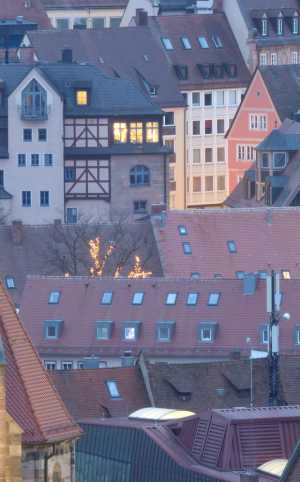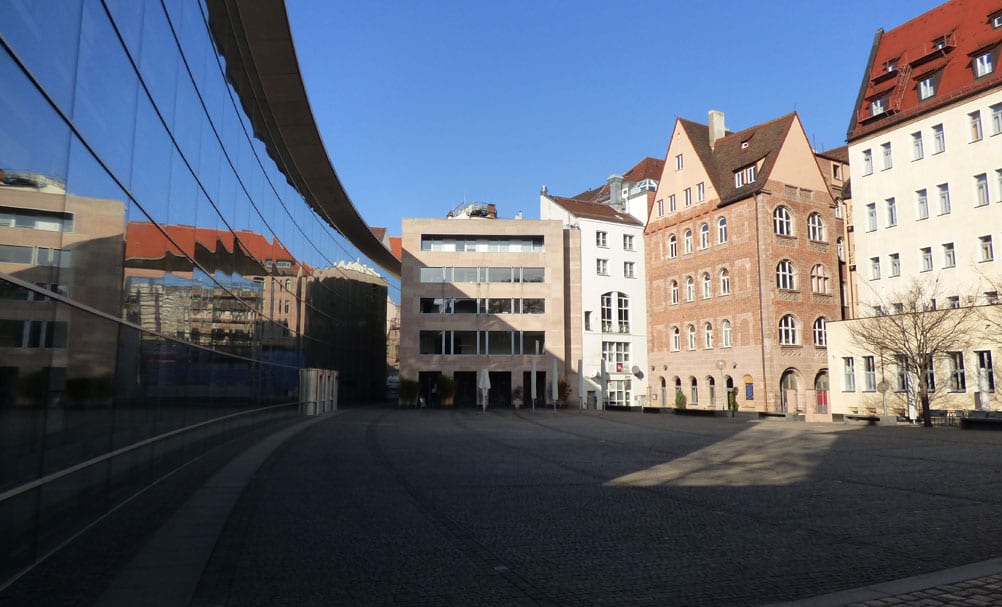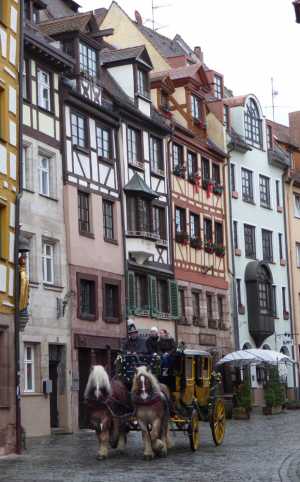Nuremberg is a city in Franconia in the south of Germany. It is Franconia’s largest city, which makes it the economic, social and cultural center of Franconia. It is situated on the Pegnitz River and the Danube Canal. It is located about 170 kilometers north of Munich.
History is written in its streets
Nuremberg, is an amazing place. Being here is an experience no one should avoid. Sometimes, it’s difficult to swallow given all that took place on those grounds. Visiting this city is about confronting the past and learning from the mistakes made.
In Nuremberg’s case, we are talking about the actions and horrors forced upon by Adolf Hitler whose legacy to Nuremberg is a tainted and virulent.
After all, Nuremberg was his favourite city. He saw the city as a classic example of a city rich in Germanic and imperial history.
Nuremberg became the venue for the Nazi Party Rallies and subsequently the Nuremberg Trials. The city and it’s residents paid a hefty price for Nazi Germany’s obsession with the city.
Thousands of lives were lost and the entire city was destroyed by the Allied forces on 2nd January, 1945 which led one local to describe it as a ‘hell on earth.’

As I saw, the city has a dreadful burden of history to bear, but it bears it honestly and well. Some of the most important World War 2 sites and museums are located here:
Nuremberg’s Palace of Justice: this is where the 1945 Nürnberg trials were held. It’s possible to see courtroom 600 where 21 Nazi war criminals were tried and convicted. Former Nazi Party Rally Grounds: a large stadium and parade ground. It was completed in 1933 and hosted 6 of Hitler’s biggest Nazi Party rallies.
World War II Art Bunker: a former bunker transformed into an art gallery.
Kongresshalle: the headquarters of the Documentation Centre Nazi Party Rally Grounds, which was a meeting place of the Third Reich.

But this is a German city, by this meaning that from those ashes, the locals have painstakingly rebuilt the city, helping restore much of the city’s original character and medieval charm.
Walking around the sandstone facades and timber framed buildings of present day Nuremberg is a symbol of the courage of the people and a reminder of the resilience, power of the human spirit.
I thinks its important to notice that teh most important trial (Nuremberg Trials) of the XX century where held here, an election filled with symbolism.
Those trials had to take place in a city that was in ashes so that judging the liders that where alive (or didn’t escape) had more intensity.
Much more than a tainted past
But, as I came to see for my self Nuremberg is much more than a tainted, obscure and sad past.
In my opinion this is one of Germany’s most underrated cities.
There’s so much to enjoy the beautiful architecture, great museums, craft beer, a whole bunch of waist expanding gastronomic delights and very friendly people.
When people think of Nuremberg, they usually think of gingerbread, toys, Christmas, the Reich Party Rally Grounds or the Nuremberg Trials.
But the old town of Nuremberg in the shadow of the towering imperial castle is more than that. The city is dominanted by the castle, a symbol of the Imperial power.
Gothic churches, splendid patricians houses and romantic corners and spots. An atmosphere of lively co-existence between medieval and modern, between the past and the present, prevails in Nuremberg.
It is the second largest city in Bavaria. It is often overshadowed by Munich.

Visitors flock to Nuremberg for its open air markets, world class museums celebrating local culture, and culinary specialties of sausage and gingerbread.
The fact that there’s an explorable medieval castle and a legendary Christmas market only sweetens the deal.
So, the best way to get a sense of Nuremberg is by wandering the Hauptmarkt, the main market located in the center of Old Town.
Throughout the year, there are colourful stands, but the real attraction takes place during each Advent season. It is Christkindlesmarkt, Nuremberg’s famed Christmas market.
The wafting spice aromas lead to stands selling Nuremberg’s famous beloved gingerbread (Lebkuchen), impregnates very inch of the ambient.
Nuremberg’s castle, Kaiserburg, is situated on a hill overlooking the winding streets below. It has been a symbol of the city since the Middle Ages. There are three sections of the complex: the imperial castle fortress, the burgrave (headquarters of Medieval regional administration), and the municipal buildings of the Free Imperial City of Nuremberg (when Nuremberg was a city-state).
Sausages and fairy tales
I love eating sausages, I have been living in Germany for more than 7 years. And, in a country known for its bratwurst, many German cities have their own specialty sausages, including Nuremberg.
An authentic Nürnberger Rostbratwurst is made from low-fat pork enclosed in a lamb casing, twisted into sausages that measure from 7 to 9 centimeters long and it has to be made within city limits.
The majority of the attractions are within the city center. I would recommend either airbnb or a hotel in the city center.
During the month of December Nuremberg transforms into the fairytale of your dreams. However, if this isn’t possible your next best bet is to come in September during the Nuremberg Volksfest. There are tons of rides, biergartens, and traditional Bavarian music and dress it’s a mini-version of the famous Munich Oktoberfest.

I think that a good way to start your weekend at a cafe in the city center drinking coffee and eating wonderful baked goods. Using this time to relax.
Once you have your fill set out for your day of adventuring through the city center. If it is up to me I think that the Germanisches National Museum and explore vast galleries and walk through various aspects of German history.
There are strokes for different folks and if you happen to be into history Nurenberg has a dark past to tell. If you are into the dark history of the city, we are talking about the Medieval dungeons.
In the beginning in the 14th century, the dungeons in the vaulted cellar of Nuremberg’s City Hall were used to confine and question prisoners until a judgment could be carried out.
Twelve small cells and a torture chamber give a gloomy picture of how justice was administered in those days.
In 1322, Nuremberg, a free city of the empire, purchased the building rights for what would later become the Gothic City Hall from the monastery of Heilsbronn.

As in many other cities in the High Middle Ages, until this time the organization of markets and supplies for the population was conducted under the auspices of the Church. When the construction of the new City Hall began in 1332, the plans comprised a prison facility because the City Hall also served as the law court.
During the construction, due to flood danger the entire ground level was raised by about three meters; and so the former bread house, previously situated on the ground floor, was now transformed into a cellar, they became the dreaded Nuremberg dungeons.
Needles to say that, the dungeons are a testament to medieval judicial practices. Like many other German cities, Nuremberg used generally accepted forms of criminal proceedings.
Ok, changing scenery completely the beautiful St.Sebaldus Church is there for every visit. People only need to pay a 2 euro donation to sit and enjoy the music from the organ (often playing during the day) and the pure tranquility of this beautiful church.
It was destroyed during WWII, the church was rebuilt to mimic the structure before the war.
Nuremberg was completely destroyed during WWII. The city leaders hid the city plans in the dungeons to protect them from damage and when the war was over the citizens voted to rebuild the city like it was before the war.
Hitler’s parade rally locations still stand today and provide a somber reminder of the horrific events that took place during WWII. But, if someone really wants to take in all that Nuremberg has to offer spend today exploring the Documentation Center which takes you through the entire history of Hitler’s regime and through his rally grounds. I would suggest spending at least 3 hours here to really take it all in.
What spring brings
Changing subject once more, spring brings a warm glow to this Bavarian city.
The second half of March sees Bavaria’s beautiful second city emerging from winter: the last snows melt away from the elegant Altstadt (Old Town), and spring takes over in the leafy surroundings.

In many ways, it’s very different from its Bavarian counterpart Munich; it’s cheaper, less metropolitan and more historic and quaint, plus the bratwurst is different.
All in all, I really enjoyed my trip to Nuremberg. Everyone I met was so nice (exeptions can be found in all places) and it was easy to find my way around town. What I liked most about Nuremberg is that it’s not crowded and there’s so much history.


